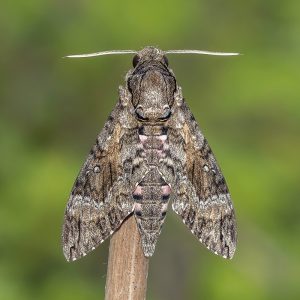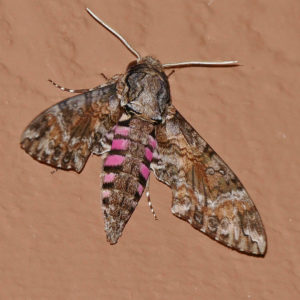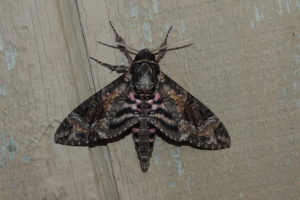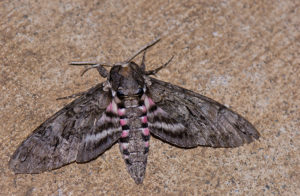Pink Spotted Hawk Moth (Agrius cingulata)
The pink spotted hawk moth is a member of the family of hawk moths and was first described by Danish zoologist Johan Christian Fabricius in 1775.
en.wikipedia.org
Scientific Classification
- Family: Sphingidae
- Genus: Agrius
- Scientific Name: Agrius cingulata
Description and Identification
Caterpillar
The final color of the larva may vary drastically; it can be brown, gray, green, or yellow. They are large, bulky, and have a horn. Black dorsolateral stripes run diagonally throughout their body, connecting to a series of black oval spots.
Pupa
After maturing, the caterpillars pupate underground during winter.
Adult Moth
Sexual Dimorphism: Present but not prominent.
Color and Appearance
The body is brown, but a series of pink and black bands can be seen on the abdomen in some individuals. A pair of blue eyespots is observable on the abdomen, as well as a brown line separating the two sides.
Forewing: When the wings are open, they are a mottled gray-black color with a series of spots seen near the end. When the wings are closed, the patterns remain observable.
Hindwing: When the wings are open, black and gray lines can be observed, alongside a fuchsia pink color. When the wings are closed, the pink color becomes hidden.
Average wingspan: 95-120 mm
Flight pattern: Erratic
Season: June-October; in some parts June to November
Eggs
Eggs are greenish and translucent, spherical, and 1mm in diameter.
Quick Facts
| Distribution | Primarily in the Americas, including Argentina, Mexico, and the Caribbean, to the southeastern United States, Colorado, Michigan, Maine, Texas, southern New Mexico, Arizona, and southern California. In Canada, it is seen in British Columbia. In western Europe, mainly Portugal and the UK |
| Habitat | Open areas and tropical lowlands |
| Lifespan of Adults | 10-30 days |
| Host Plants | Pawpaws appear to be most preferred; also sweet potato, morning glory, and jimsonweed |
| Adult Diet | Nectar from flowers like moonflowers, morning glories, and petunias |
Scientific Classification
- Family: Sphingidae
- Genus: Agrius
- Scientific Name: Agrius cingulata





